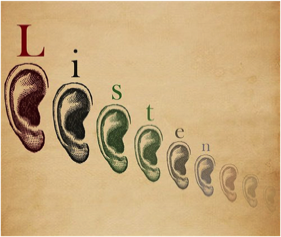Audible Signs

Friday, June 13, 2014
It’s been obvious for a long time, that many people with vision impairments would prefer signs that speak out. However, nothing
is quite that simple!
First, how do you have audible signs that speak only to the person who wants to hear them? No one wants a cacophony of signs speaking out up and down corridors of office buildings or schools.
How do you let people who are blind know that there is an audible sign? Should it always be anchored to a tactile sign?
Should people who are blind be required to purchase some sort of receiver in order to hear an audible sign? Should there be devices to check out when you enter a building? Can audible signs be linked to a smart phone? What about people who don’t have smart phones, or can’t afford them?
So many questions! And at this time, we certainly don’t know all the answers.
Here are some audible sign systems that have been tried in the United States. There are others in Europe, and particularly one that got a lot of publicity some years ago that was developed in the Czech Republic.
Talking Signs® This is the most well-known system, and has the most installations that we know of, chiefly in the downtown area of San Francisco, where it was developed at Smith Kettlewell. I have personally tested this system, collaborated with the owner of the business at a trade show, and watched blind people use it. You must have a receiver. The devices are not linked to tactile signs and are used more as general wayfinding aids than identifiers for specific offices or suites. An individual from the company actually programs each sign, which speaks in a human voice -- the voice of whomever programmed it. The user has a receiver, and scans the area. When the receiver is pointed directly at the location of the identified area, the voice becomes clear, with no static. The user then can walk toward the sound, and scan further to proceed along the way. Naturally, the major drawback is having to have a special receiver, and having to either wear earphones, or let the sign speak out to everyone along the path. It’s also very expensive to install, since it is hardwired, and a technician programs it.
TouchEar This was a very effective tactile system that was connected to room identification signs. Although you can still find the specifications on the web if you Google the term, the developing company, for whom I was a consultant, is no longer in business. This was a “push-button” audible sign. It consisted of a little chip on which you could record any 10 second message. It, along with long-lasting replaceable batteries, was housed in a bull-nosed enclosure that could be located below a tactile sign. It could repeat the room number or name, plus could add other non-tactile information from the sign, or even direct you further. For instance, it could say “Women’s Restroom. Men’s Restroom across the hall. Drinking fountain on the left.” Of course the major drawback was that a prankster could stand and push the button dozens of times, and the battery might wear out. As we all know, it’s lack of maintenance of such devices that often makes them fail. And, of course, the enclosure could be vandalized since it is located within easy reach.
SignTalk™ This is a system that I worked on with En-Vision America. Originally, it was developed for their “talking prescription bottle” program. It uses an inexpensive “smart label” that can be programmed with a laptop and special software they have developed. It works a lot like TouchEar, but does need a receiver. The label is installed beneath a piece of plastic, which could even be a tactile plastic sign. We used a small piece of acrylic with a screened decorative logo, and a tactile “bump” to alert the blind person that it was an audible sign, and they were all located adjacent to the tactile signs for each door. Again, you would program a message, and could include both the room identification and a few brief sentences of directional information. One drawback was that, in order to keep it inexpensive, the labels were small, and you had to get really close to the sign to get it to speak out. The developer and I both felt it had a lot of promise, but needed refinement. However, having to provide the receivers was a major disadvantage.
Smart Phones Obviously, the solution now probably lies with smart phones. Although everyone doesn’t have one, they are becoming less expensive, and could even be checked out for use within large buildings. I have checked out several of these. One, for instance, is called “All Access.” There is a European program called “Georgie.” One of the challenges for wayfinding within buildings may be to be sure that rooms are labeled in a manner that can be picked up by these devices. Streets are already mapped for GPS use, but buildings may also need this type of mapping. Perhaps that will be an incentive for better room numbering systems!
As I have time to research some of the new programs, I’ll try to remember to add them here, so you can check them out yourself.
ADA Advantages
The ADA doesn’t just bring advantages to people with disabilities, although of course that is its first and most important outcome when the law is observed. Business gains as well, from more customers and good employees. Families gain as everyone can participate in the community -- no one is left behind. And that’s just the beginning.



